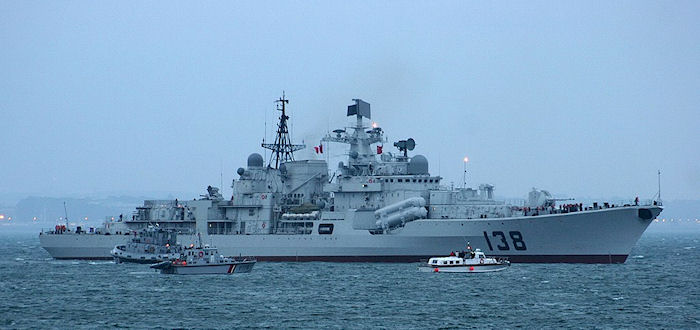While still a long way off from challenging the United States as the predominant world naval power, China’s modernized People’s Liberation Army Navy (PLAN) is beginning to take a more assertive role in an expanding theater of operations.
Previously content on patrolling coastal waters and preparing for an armed conflict with Taiwan, China now has a naval presence all along commercial sea routes to the Middle East and has stepped up military operations in the contested waters of the East and South China Seas.
On April 10, a Chinese flotilla of 10 destroyers, frigates, and submarines from the East Sea Fleet, based in Ningbo, travelled through Japan’s Miyako Straight on to the Pacific to conduct open ocean military exercises. A few days earlier, China’s North Sea Fleet, based in Qingdao, passed through the Bashi Straight between the Philippines and Taiwan to do similar military exercises in the South China Sea. The PLA Navy’s recent operations in the region have troubled China’s coastal and island neighbors, with Japan’s government particularly irked by the proximity of the maneuvers to Japanese territory.
Chinese President Hu Jintao met with Japanese Prime Minister Yukio Hatoyama during the Nuclear Security Summit in Washington on April 13, assuring him that China’s intentions in the East China Sea are to turn the region into an area of peace, friendship, and cooperation.
"China does not hold an intention to challenge the U.S. in the central Pacific or engage in a military clash with Japan in close waters, though it is willing to protect its core interests at any cost," China’s state-owned Global Times printed today in an attempt to comfort the world. The problem with the statement is that China has expanded what it defines as its "core interests." Beijing has previously reserved the term for areas such as Tibet and Taiwan, but now places its territorial claims in the South China Sea under the "core interest" category, according to the New York Times. Beijing may find its Southeast Asian neighbors, including Brunei, Indonesia, Malaysia and the Philippines, take issue with that statement.
U.S. officials in Washington are also fretting over the implications of a growing Chinese presence in the Middle East. In March, two Chinese frigates made port in the United Arab Emirates’ capital of Abu Dhabi; the first time in modern history that a PLAN vessel has docked in the Middle East. Beijing also committed three warships to the Gulf of Aden in December 2008 to aid with international antipiracy efforts; the first time in modern history Chinese naval forces have been deployed beyond the Pacific Ocean.
Quantitatively, China and the United States are already on a similar playing field. A 2009 Pentagon report estimated the number of active Chinese naval vessels at 260, including 75 major warships and more than 60 submarines, compared to the U.S. Navy’s 286 active vessels.
Qualitatively, though, China’s navy remains decades behind that of the United States. Ten of the American Navy’s 286 active vessels are Nimitz-class nuclear powered supercarriers – each one capable of operating continuously for up to 20 years without refueling while holding up to 90 aircraft and 5,600 personnel. In contrast, China doesn’t have any aircraft carriers, and although Beijing has revealed that it will complete the first Chinese carrier within the next few years, the United States will surely belittle that accomplishment when it launches the new Ford-class supercarrier in 2015.
China’s official military budget for 2009 stood at US$70.3 billion, good for second highest in the world, but the Pentagon estimates that China’s military spending last year was in the range of US$105 billion to US$150 billion. Whichever figure you use, it pales in comparison to the roughly US$533.8 billion proposed by U.S. President Obama for 2010. That translates into an expensive long-term battle for China if it wants to challenge America’s global military presence in the 21st Century.




